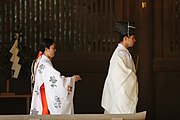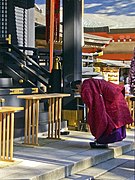Kannushi
- View a machine-translated version of the Japanese article.
- Machine translation, like DeepL or Google Translate, is a useful starting point for translations, but translators must revise errors as necessary and confirm that the translation is accurate, rather than simply copy-pasting machine-translated text into the English Wikipedia.
- Consider adding a topic to this template: there are already 3,691 articles in the main category, and specifying
|topic=will aid in categorization. - Do not translate text that appears unreliable or low-quality. If possible, verify the text with references provided in the foreign-language article.
- You must provide copyright attribution in the edit summary accompanying your translation by providing an interlanguage link to the source of your translation. A model attribution edit summary is
Content in this edit is translated from the existing Japanese Wikipedia article at [[:ja:神職]]; see its history for attribution. - You may also add the template
{{Translated|ja|神職}}to the talk page. - For more guidance, see Wikipedia:Translation.
| Part of a series on |
| Shinto |
|---|
 |
| Beliefs
|
|
| Important literature
|
| Practices |
|
|
A kannushi (神主, "divine master (of ceremonies)", originally pronounced kamunushi), also called shinshoku (神職, meaning "employee/worker of kami"), is a person responsible for the maintenance of a Shinto shrine (神社, jinja) as well as for leading worship of a given kami.[1] The characters for kannushi are sometimes also read as jinshu with the same meaning.
History
Originally, the kannushi were intermediaries between kami and people and could transmit their will to common humans.[2] A kannushi was a man capable of miracles or a holy man who, because of his practice of purificatory rites, was able to work as a medium for a kami. Later the term evolved to being synonymous with shinshoku - a man who works at a shrine and holds religious ceremonies there.[1][3]
In ancient times, because of the overlap of political and religious power within a clan, it was the head of the clan who led the clansmen during religious functions, or else it could be another official.[3] Later, the role evolved into a separate and more specialized form. The term appears in both the Kojiki (680 AD) and Nihon Shoki (720 AD),[3] where the Empress Jingū and Emperor Sujin respectively become kannushi.[2]
Description
Within the same shrine, such as at Ise Jingū or Ōmiwa Shrine, there can be different types of kannushi at the same time; these may be called, for example, Ō-kannushi (大神主), Sō-kannushi (総神主), or Gon-kannushi (権神主).[2][3] Kannushi are assisted in their religious or clerical work by women called miko.
Kannushi can marry, and their children usually inherit their position.[4] Although this hereditary status is no longer legally granted, it continues in practice.[5]
Vestments and ritual objects
The clothes kannushi wear, such as the jōe, the eboshi and kariginu, do not have any special religious significance, but are simply official garments previously used by the Imperial court.[4] This detail reveals the close connection between kami worship and the figure of the Emperor.[4] Other implements used by kannushi include a baton called shaku and a wand decorated with white paper streamers (shide) called ōnusa.
-

- A kannushi in full dress, Katori Shrine
-
 A kannushi wearing a kariginu and an eboshi hat
A kannushi wearing a kariginu and an eboshi hat
Education
To become a kannushi, a novice must study at a university approved by the Association of Shinto Shrines (神社本庁, Jinja Honchō), typically Tokyo's Kokugakuin University or Ise's Kogakkan University, or pass an exam that will certify his qualification.[5] Women can also become kannushi, and widows can succeed their husbands in their job.[5]
Onshi
An Onshi or Oshi (御師) is a lower level Shinto priest analogous to a deacon or an acolyte. They are considered between a layperson and clergy.
See also
References
- ^ a b * Kannushi (in Japanese), Iwanami Kōjien (広辞苑) Japanese dictionary, 6th Edition (2008), DVD version
- ^ a b c Nishimuta, Takao (2007-03-28). "Kannushi". Encyclopedia of Shinto. Kokugakuin. Retrieved 2009-10-16.
- ^ a b c d Moriyasu, Jin. "Kannushi". Nihon Hyakka Zensho (in Japanese). Shogakukan. Archived from the original on 2012-12-09. Retrieved 2009-10-16.
- ^ a b c Nishimura, Hajime (1998). A Comparative History of Ideas. Motilal Banarsidass. ISBN 978-81-208-1004-4.
- ^ a b c "Shinshoku". Encyclopædia Britannica Online. Retrieved 2009-10-16.
External links

- Kannushi, Encyclopedia of Shinto













